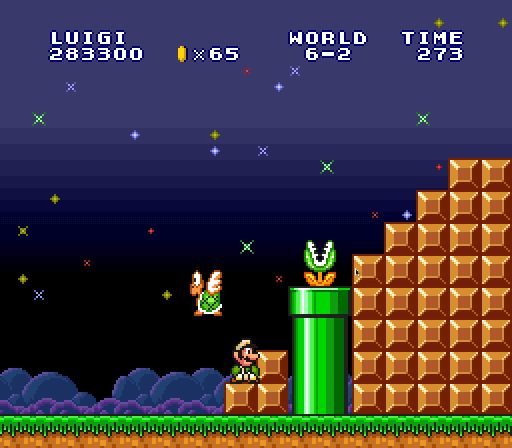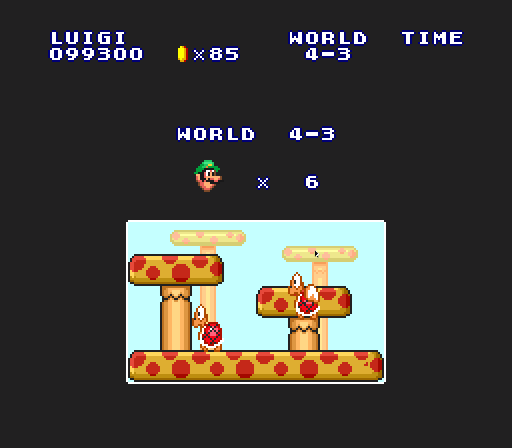
What stands out most is that, despite this game taking place in the Mushroom Kingdom & having plenty o’ mushrooms in ?-blocks, the terrain is rarely composed o’ mushrooms, but more oft those contradictory blocks that are a mix o’ natural cracked rock & unnatural perfect square shape ( or grass, if playing Super Mario All-Stars ). Having much mo’ red & yellow & a li’l less brown & green certainly makes the level feel mo’ colorful than most other daytime levels, ’specially in All-Stars with the mushroom platforms in the background.
But graphics aside, this level’s arrangement o’ elements seem mo’ modern than most other levels in this game. Other than the green hill levels ( World 1-3 probably being the most well-known example ), most o’ this game’s levels are flat land with a few walls & holes here & there. But e’en most o’ those levels are just a horizontal line o’ hills going from left to right, with slight variances in height, such as the other level with prominent weight pulleys, World 6-3, or merely use multilayered hills to create proto-Sonic alternate routes, like World 1-3, 5-3 ( which is just a clone o’ 1-3 ), & 3-3. But World 4-3 uses multilayered mushroom towers not as a means for alternate routes, but as a challenge itself. Just after the 2nd mushroom, you see a mushroom tower @ just the right height to stymie you. It grants alternate routes, but unlike the other levels, the alternate routes aren’t arbitrary, but have different challenges: if you go below the mushroom tower, you have to jump low ’nough not to bonk your head on it, but high ’nough to make it to the next platform under it; to go ’bove the tower, you must run & jump high ’nough to reach it.
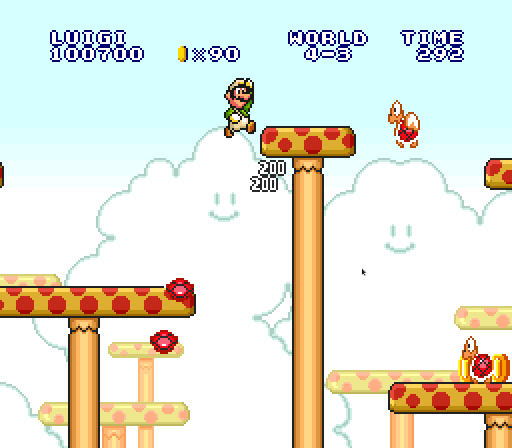
& in this level, the red Koopa is, for once, a greater hindrance than the green Koopas, as you have to time jumps so that you don’t run into them during their patrol back & forth o’er the mushroom. Thanks to the timing & placement o’ the red Koopas on the 2nd mushroom, the jump to it will leave li’l space & time to jump o’er them before they reach you ( which is very tricky to pull off in Super Mario Bros. Deluxe, thanks to its much smaller screen, allowing e’en less reaction time ).
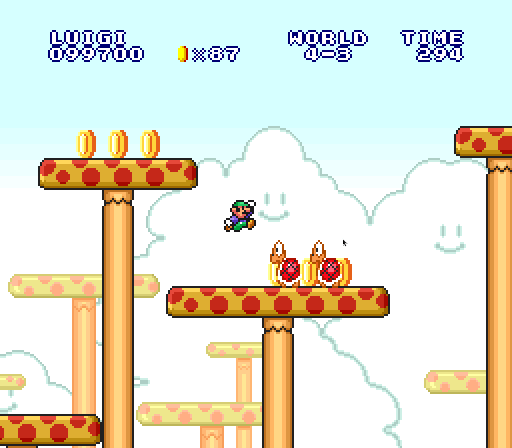
& then there’s the weight pulleys, an early version o’ a “level gimmick” that makes this level feel like a proto Super Mario World level, which used just ’bout every type o’ moving blocks or platform you could think o’. Their key strength is how much control they give you. The most obvious way is that they let you move them up & down all o’er; but the subtle version o’ this strength is how they don’t force you to slow down, a problem with many level gimmicks in games. If you know what you’re doing & have the maneuverability to do so, you can pass pulleys onto the rest o’ the level without stopping.
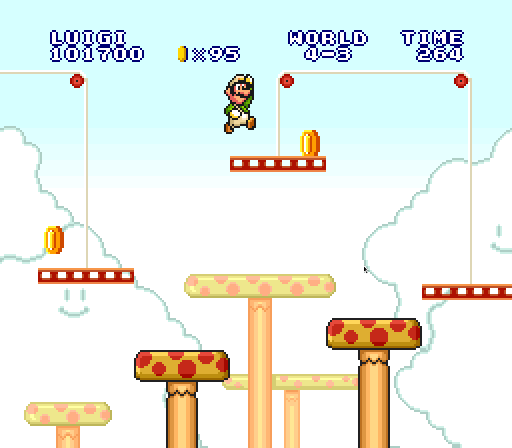
I also like the way the mushroom block is positioned on the edge o’ a mushroom platform with a thin platform just below. It’s the 1st time the game truly threatens you with destroying your mushroom before you can get it. Compare this with 4-1’s 1st mushroom position: it has a much larger plot o’ land to move before falling into a pit, & the Spinys offer a greater obstacle than gravity. The lower mushroom platform softens the challenge, which fits this level’s placement difficulty just after the middle o’ the game.
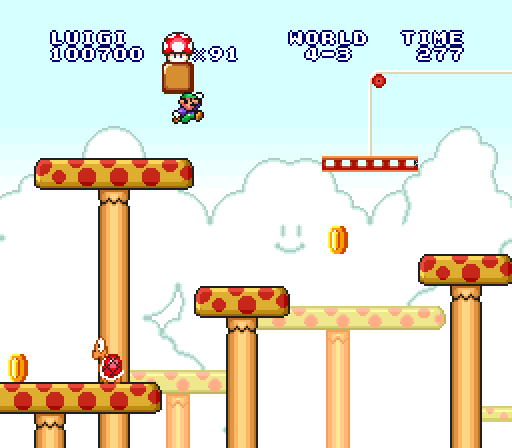
The ending is 1 o’ the few without the iconic staircase, replaced by a platform moving up & down. This does not make reaching the flagpole harder in the slightest, but it does make reaching the top o’ the flagpole a bit harder, & makes doing so while getting 6 fireworks much harder, which those gaming for the score medal in Super Mario Bros. Deluxe’s challenge mode will know all too well.
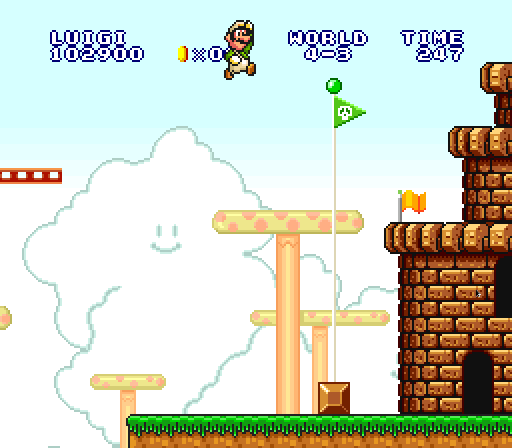
’Mong the pulley levels, this is the weakest ending, with 3-3’s pulley @ the end with the end closer to the flagpole lower down the best. A platform moving up & down doesn’t have much to do with this level, which only has 2 other vertical floating platforms, thrown in the middle so that they’re easy to forget ’bout. 6-3 focuses much mo’ on these types o’ platforms & ends with a series o’ vertical platforms leading to a hill seen in almost every other world’s 3rd level, just wintry white. I think 4-3 should’ve had a series o’ mushroom hills leading to the flagpole while 6-3 should’ve ended with a vertically rising & falling platform, but with a gap ’tween the platform & the flagpole to add some actual challenge ( since we’re moving 2 worlds later, after all ).
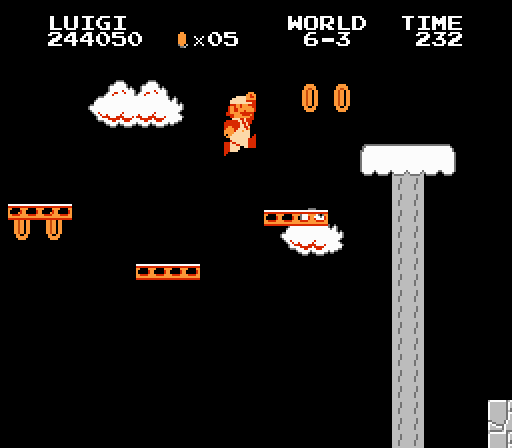
Honorable Mentions
In fact, 6-3 is a strong competitor to 4-3 — perhaps e’en better, looking @ it with fresher eyes. Its wintry white & gray blocks o’er a black background is arguably rarer than 4-3’s red mushrooms, since they also appear in the warp zone in 4-2 ( though you can’t see both in the same playthrough ), though you do see this same palette in every castle level, just with a different tileset.
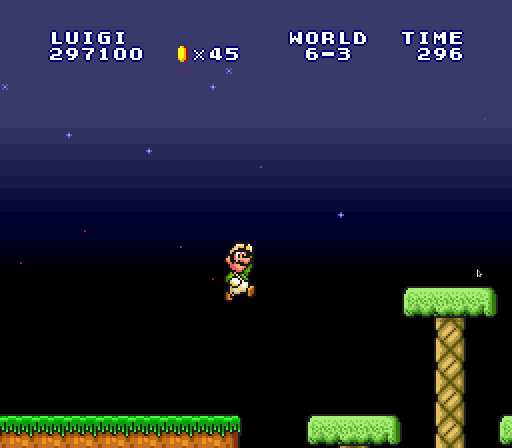
Sadly, this level loses this special color scheme in the Super Mario All-Stars, whose Super Mario Bros. remake otherwise had superior graphics & music — though inferior gameplay, thanks to errors the programmers made with the brick-breaking physics, ’less you use the brick-fix rom hack. Why they didn’t make snowy graphics for the hill tileset like they did for evening levels that weren’t e’en wintry-looking in the original, like 3-1, I have no idea. Super Mario Bros. seems to be a game destined to be plagued by imperfect remakes.
It also arguably has a mix o’ mo’ exotic elements, replacing common red Koopas with a few red springs & Bullet Bills. Howe’er, the red Koopas allow for mo’ fine-tuned jumping challenges, while the Bullet Bills just come in @ random places, which can make certain circumstances outright unfair, rather than clever. The use o’ the spring is well done: the 1st is just for bonus coins & a higher vantage point, which you can still reach with careful jumping without it, while the 2nd is, save for some particular expert maneuvering, mandatory to reach the next platform high ’bove. They don’t do much else with this element, which, quite frankly, is only meaningful as a challenge in how janky timing jumps off it can be.
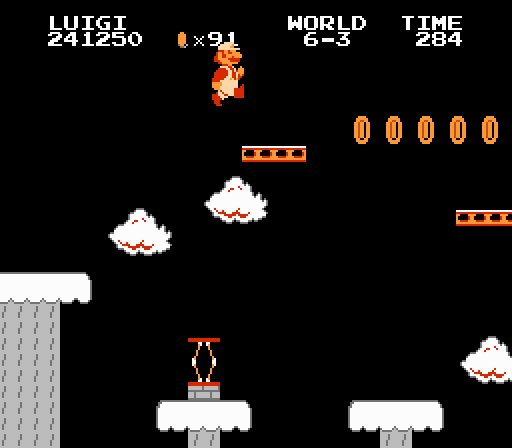
6-3’s mushroom block is e’en better than 4-3’s, & fits its moving platforms theme well. It is positioned just under a horizontally moving platform, upping the challenge from 4-3’s mushroom by making it much easier to make the mushroom fall into the pit without a safety platform below to give an extra chance.
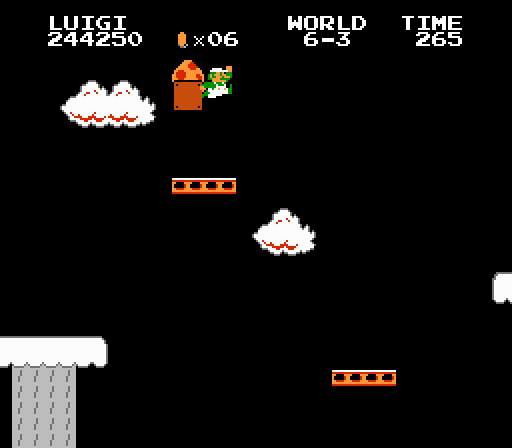
Like 4-3, you can race through the whole level without stopping if you know what you’re doing. Like Sonic games later on, if you keep to the top the level goes smoothly, but if you let yourself fall to the bottom, you can run into tricky jumps, such as those wherein the weight pulleys are so high that they’re hard or impossible to reach, but are still low ’nough to threaten to bonk you as you try to jump under them & interrupt your jump.
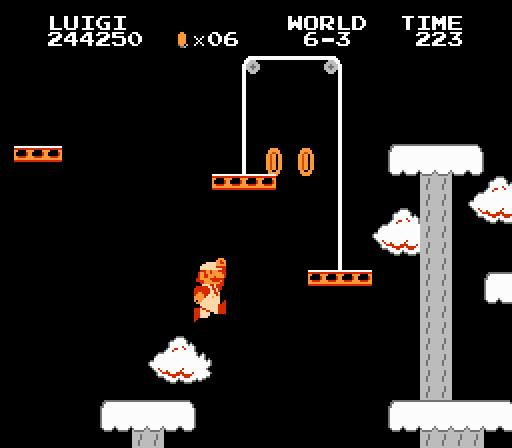
I’m also quite partial to 6-2, though it’s definitely a 3rd to 4-3 & 6-3. It’s a rather long long full o’ tricky arrangements o’ pipes with Piranha Plants — usually only emphasized in underground levels. This makes this probably the greenest level in the game.
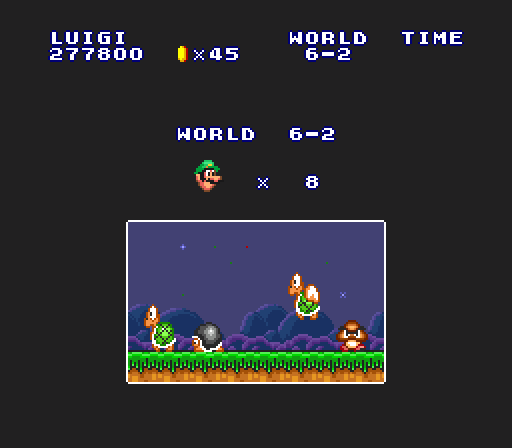
Piranha Plants are the most common enemy in the game ( yes, they are mo’ common than Goombas ), making this level feel less fresh than the 4-3 & 6-3 with their rarer weight pulleys, & Piranha Plants, who are slow & easily-telegraph their moves are not nearly as tricky. Worse, if you don’t have a fire flower, they can easily delay you, ’specially in this level.
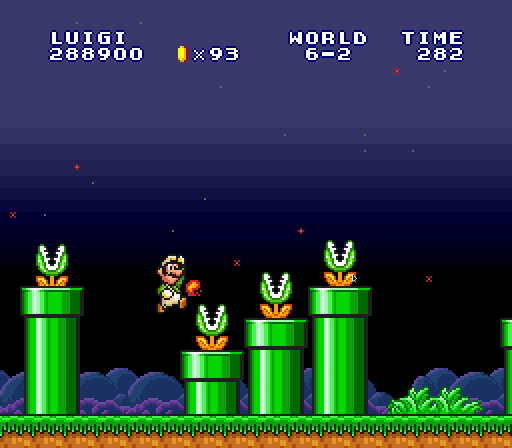
Still, this is definitely the most interesting Piranha Plant level, which calls to mind the clever arrangements found in Lost Levels levels like 5-1, 7-1, A-1, & C-1.

I also like the nighttime twist on the coin heaven, with a slightly trickier arrangement o’ cloud blocks, making it harder to collect all coins — though this coin heaven appears in 3-1 1st.
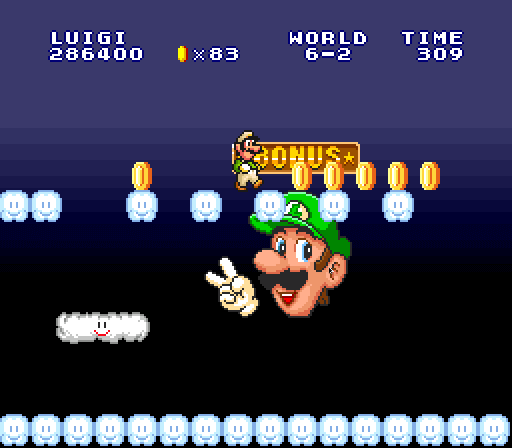
I also like the way the ending staircase adds both a hopping Paratroopa & a Piranha Plant.
